In the second half of 2023, Detroit Tiger Tarik Skubal led all major league pitchers in FanGraphs’ WAR, amassing 2.9 across 72 1/3 second-half innings.
He accrued more fWAR during the stretch than AL Cy Young winner Gerrit Cole (2.6) and NL Cy Young winner Blake Snell (2.0). He was more valuable to his team than Tyler Glasnow (2.4), Spencer Strider (2.4), or breakout star Cole Ragans (2.4) across those innings.
Among starting pitchers with at least 80 innings pitched in 2023, Skubal ranked fifth in ERA, first in FIP, third in strikeout rate, first in WHIP, sixth in swinging-strike rate, and fourth in CSW rate.
Credit to @toomuchtuma for this Skubal graph showing his 2023 dominance pic.twitter.com/lnhItgPmHU
— Tanner McGrath (@tannerstruth) February 7, 2024
He was a superstar and would’ve been a legitimate Cy Young candidate had he been healthy for the whole season – Skubal returned from flexor tendon surgery on July 4th.
Skubal was a fairly highly-rated prospect – he had a 70-grade fastball – but he finished 2021 with a 5.58 xERA across 150 innings. He improved substantially in 2022 (3.31), but nobody saw his transition into a low-2.00s xERA guy (2.28 in 2023), especially after sustaining a significant injury.
But is Skubal’s stupid 2023 sustainable or repeatable? Can he carry this momentum into 2024 and assemble an MVP performance across 150-plus innings?
Or is he due for regression?
I’m cautiously optimistic.
Skubal’s New-And-Improved Pitch Mix
Per The Athletic’s Cody Stavenhagen, Skubal made some “subtle mechanical adjustments” during his 11-month injury hiatus that helped increase his fastball velocity.
This is where Skubal’s improvements start.
His fastball velo jumped two ticks in 2023, and his 96 MPH average ranked in the top 25 among qualified starting pitchers. Skubal tossed 11 four-seamers above 98 MPH, topping out with this 99.2 MPH painted heater on an 0-2 count to get Brett Phillips looking.
Skubal's fastest pitch from the 2023 season (99.2) pic.twitter.com/b4Ydd3ThgV
— Tanner McGrath (@tannerstruth) February 7, 2024
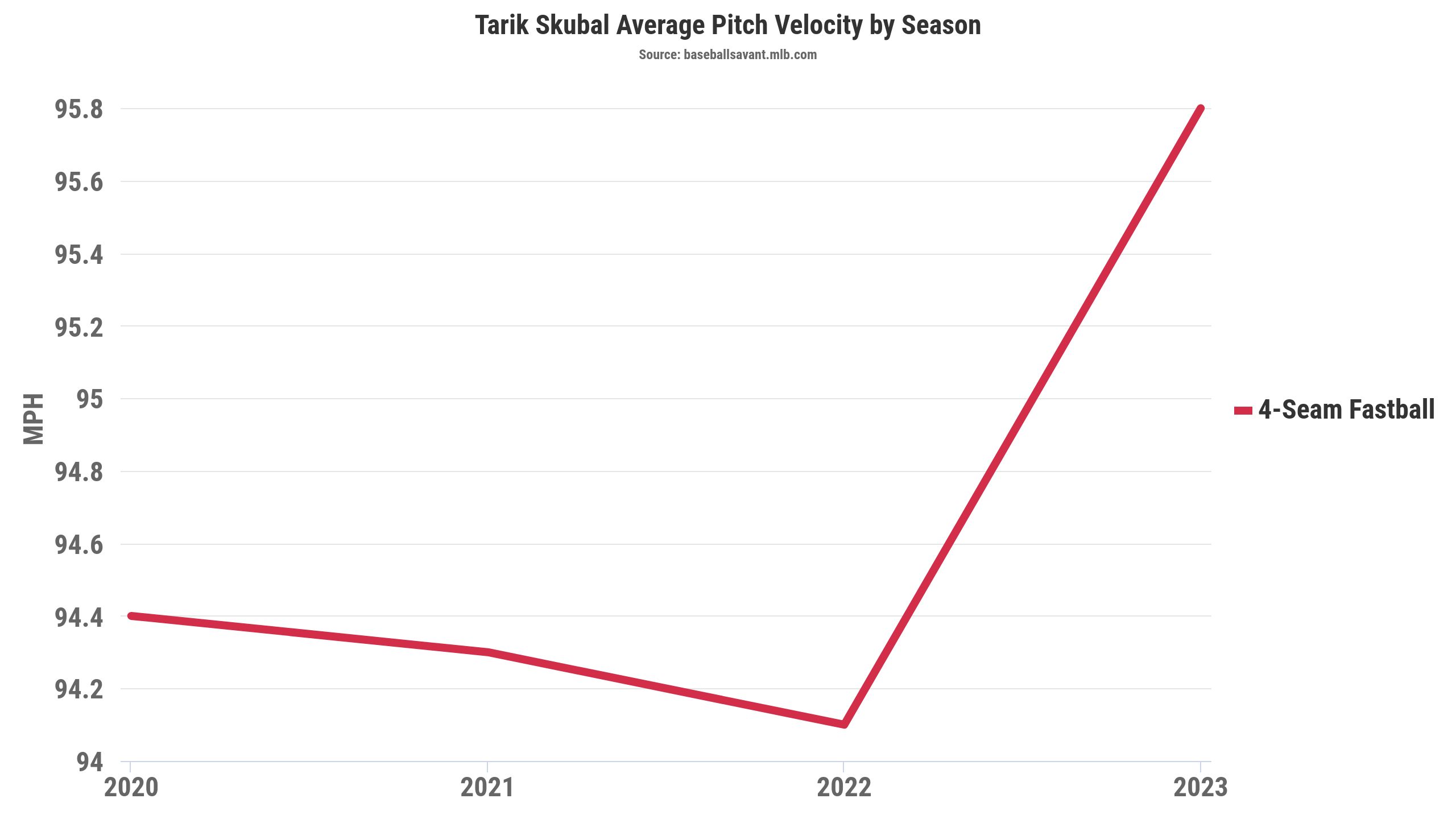
Image credit: Baseball Savant
Surprisingly, Stuff+ still isn’t uber-high on Skubal’s four-seam. But Location+ is. He improved his fastball Location metric by five points year-over-year in 2023, with a 106 mark that ranked top-10 among pitchers with at least 80 innings thrown.
Specifically, Skubal located his fastball more at the top of the zone and missed middle-middle far less often.
Here’s his four-seam heat map from 2022:
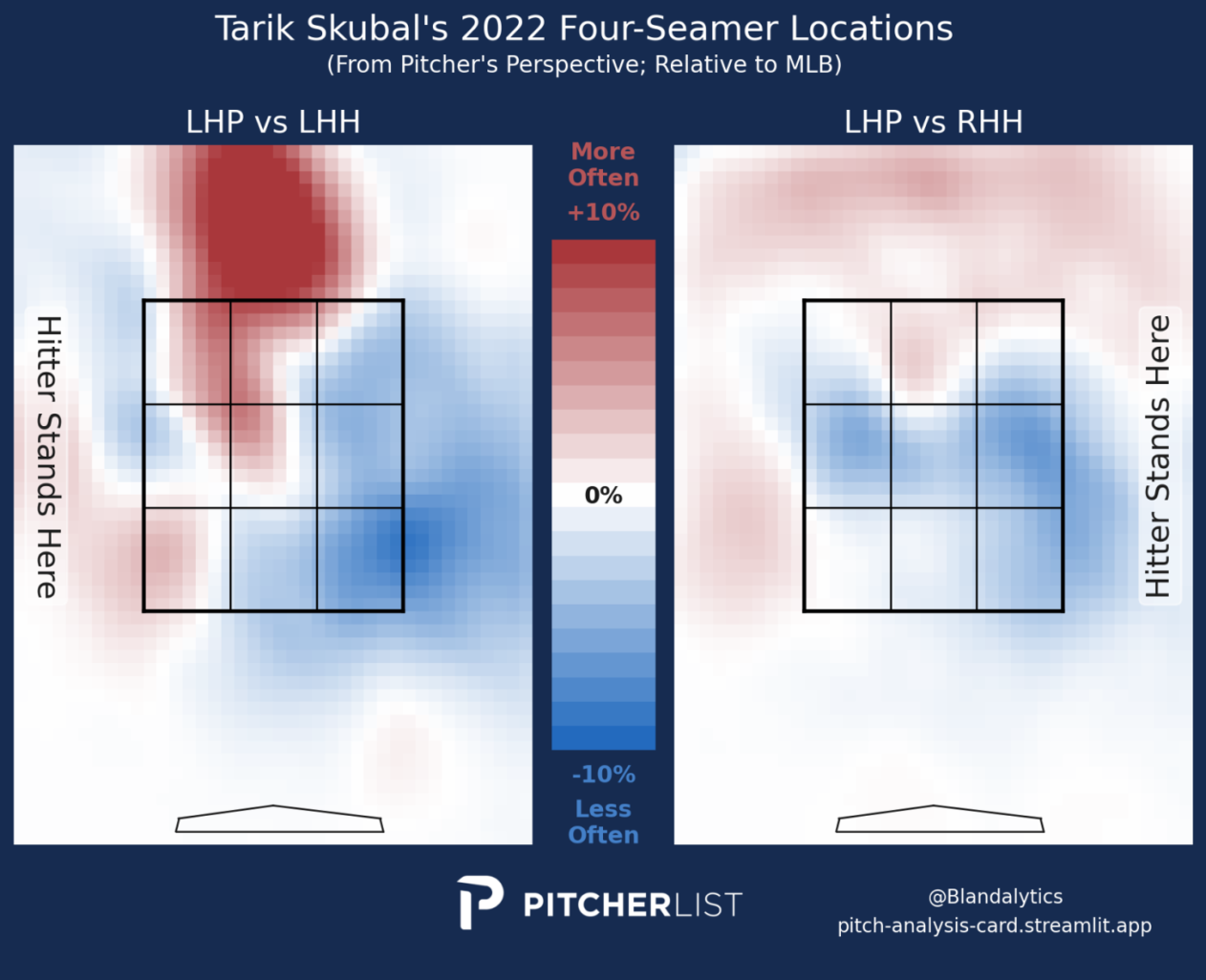
Image credit: Pitcher List
And here’s 2023:
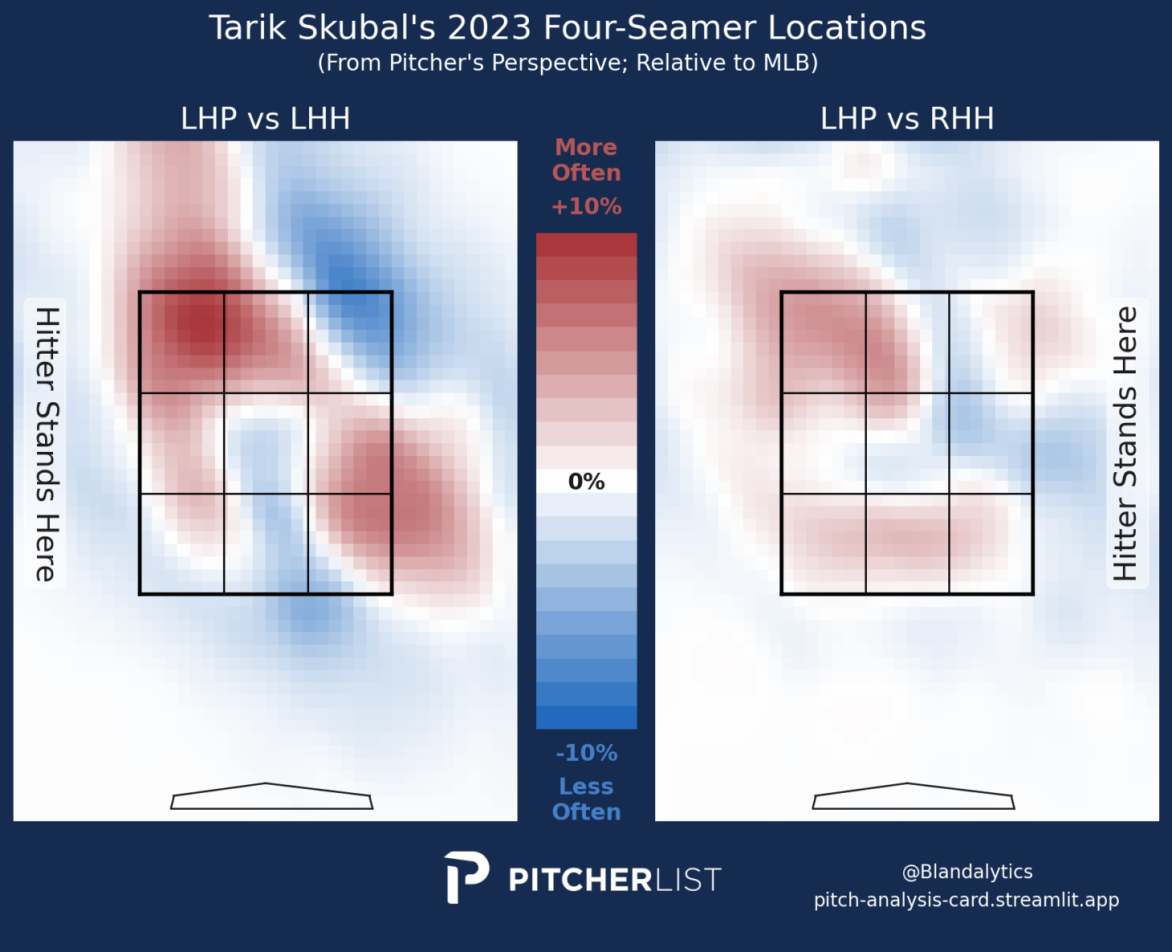
Image credit: Pitcher List
Not only did Skubal avoid middle-middle fastballs more, but he also missed above the zone less, painting the top corners consistently. That’s a recipe for success.
Between the better location and the added velocity, hitters never caught up to the heat.
Skubal’s four-seam swinging-strike rate jumped over two points from 2022 (12%) to 2023 (14.6%). His four-seam called-strike rate jumped exactly two points (18.9% from 16.9%). His four-seam contact rate dropped two points (80.2% from 82.1%).
As a result, his four-seam CSW rate jumped five points year over year (33.6% from 28.9%).
Data via FanGraphs and Pitcher List
He generated so many strikes with the pitch – his 76% four-seam strike rate was third-highest among major league fastballs – especially early in the count, where he checked in with a 68.6% first-pitch-strike rate, up from 63.6% in 2022.
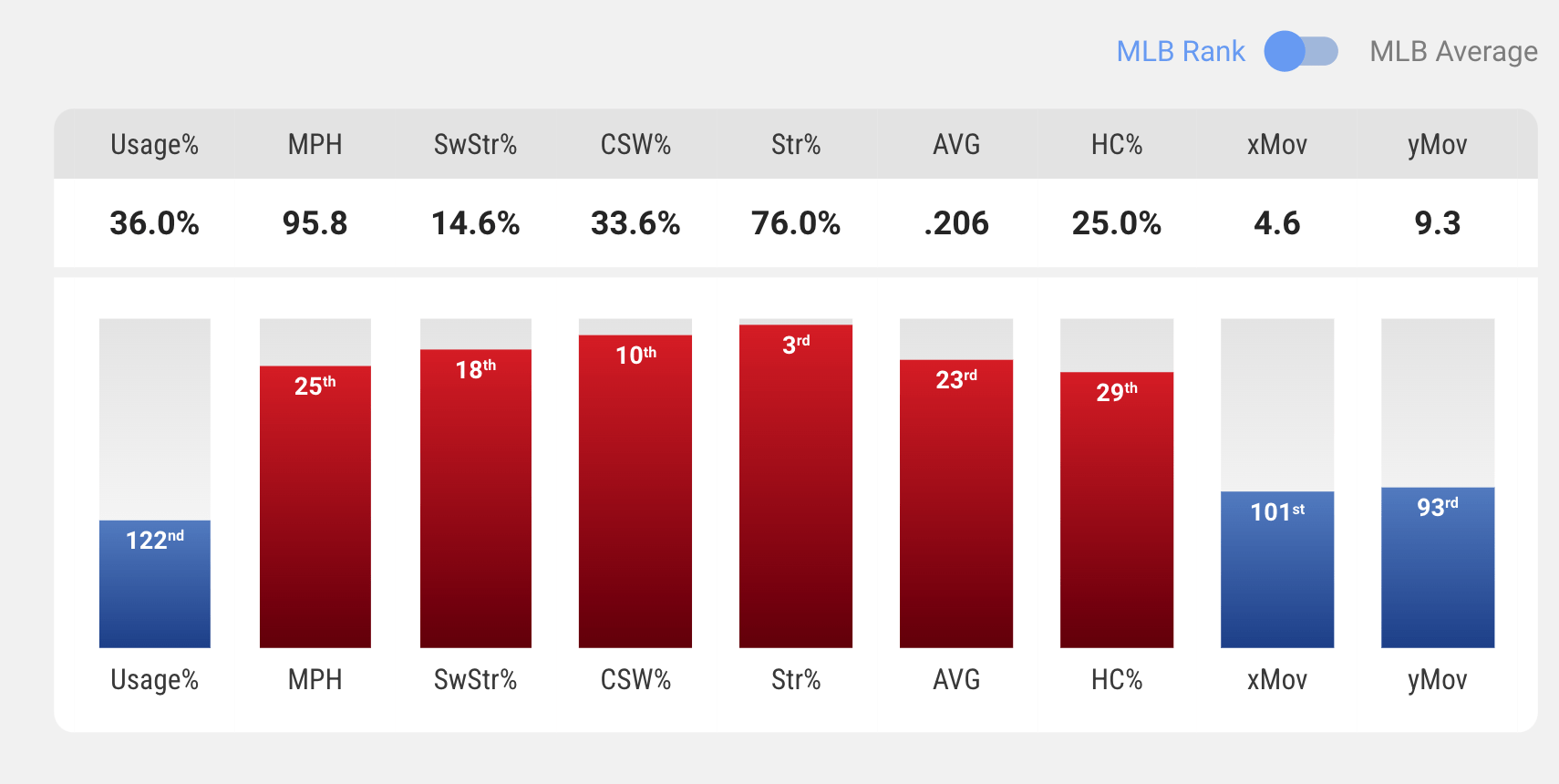
Image credit: Pitcher List
Skubal didn’t add any ride, movement, or spin to the pitch, and his extension stayed the same. Again, subtle changes that allowed velocity to come easier.
Fastball velocity isn’t everything, and correlation doesn’t imply causation. Still, there’s a trend between Skubal’s velocity and ERA.
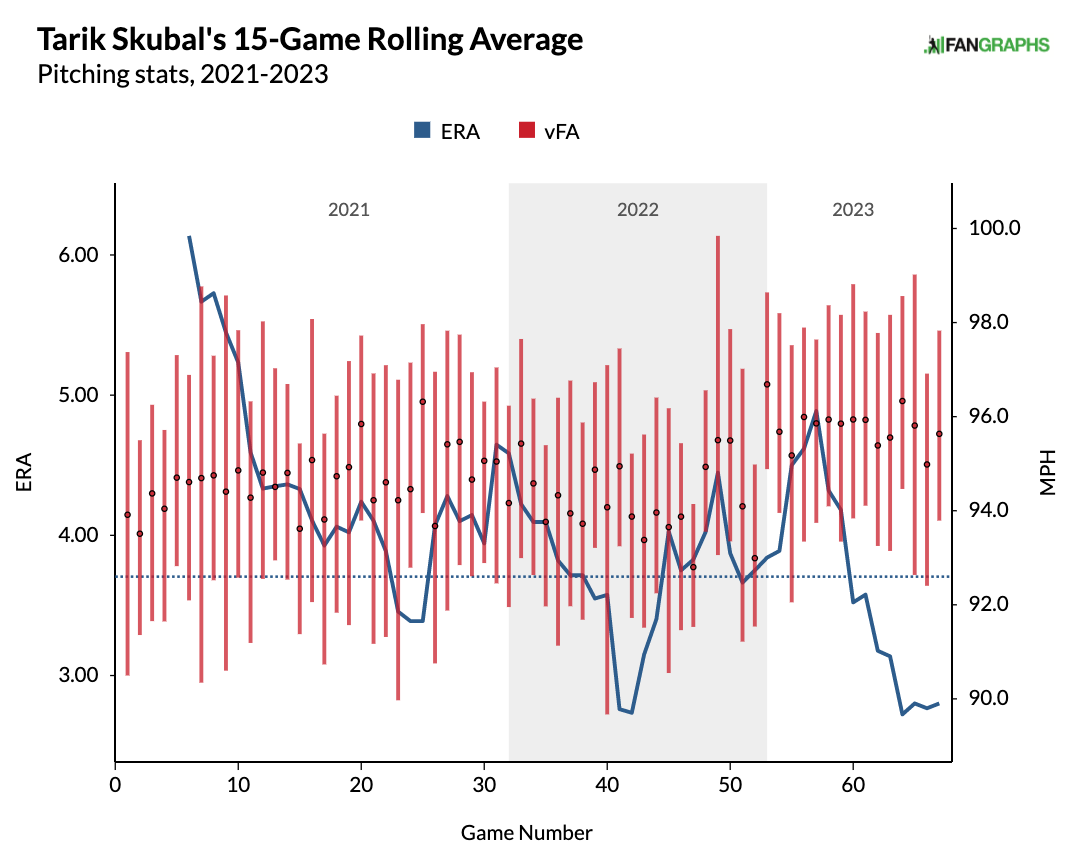
Image credit: FanGraphs
His improved fastball made his secondary pitches more effective.
Specifically, his now-main secondary pitch, the changeup, became one of Major League Baseball’s most dangerous offerings.
Skubal’s changeup tunnels well with his fastball but drops on approach with the slightest bit of glove-side break.
Tarik Skubal, 97mph Fastball and 83mph Changeup, Overlay. pic.twitter.com/2OrcQSmNSQ
— Rob Friedman (@PitchingNinja) June 5, 2021
He added a few ticks to his changeup, but his supernova fastball meant he kept a solid velocity differential between the two pitches.
Surprisingly, the vertical movement on his change has decreased significantly over the years, but that velocity differential meant he could still force over-the-top swings consistently – especially when he’s locating the fastball so well.
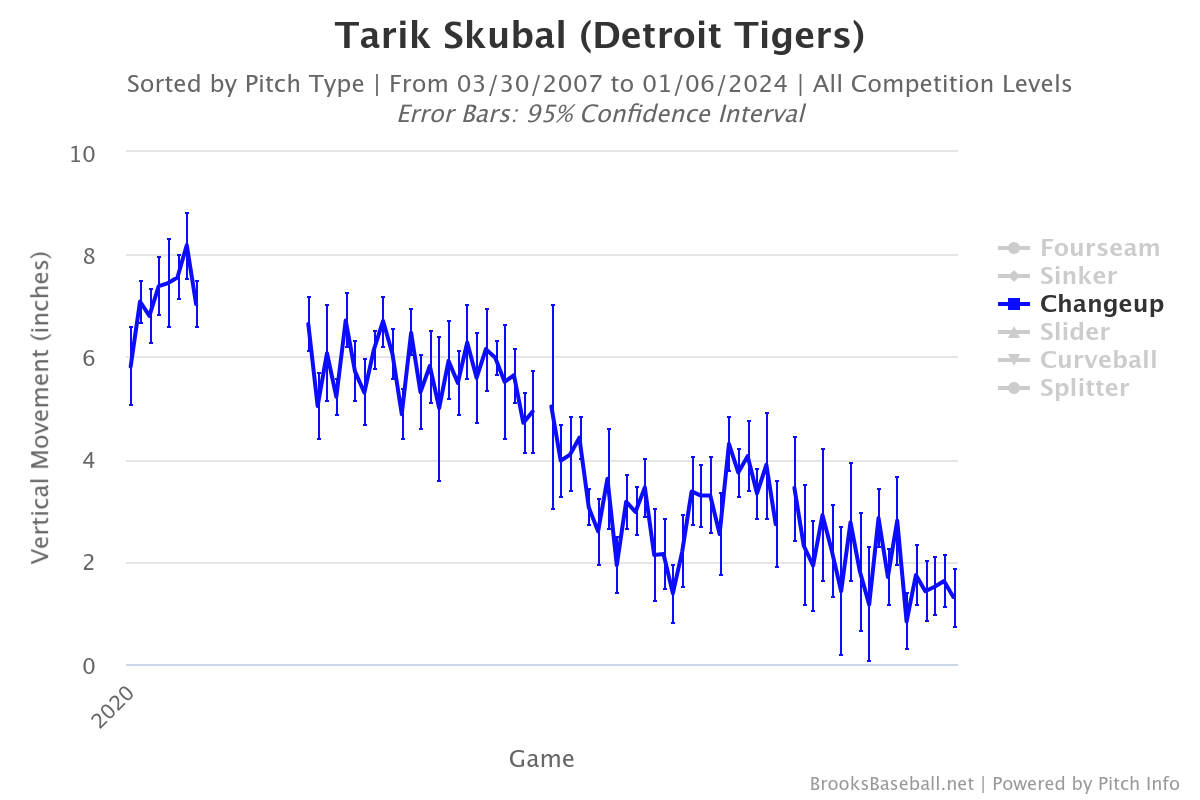
Image Credit: Brooks Baseball
There’s also some deception at work here that’s hard to quantify, as noted by Lance Brozdowski:
September 26-27 pitcher shape metrics of note. #LanceNotes
Chris Paddack returns
Reid Detmers' changeup usage
Shane Bieber — higher slot?
Tarik Skubal getting the lefty boost? pic.twitter.com/E7oOVGpC5Y— Lance Brozdowski (@LanceBroz) September 28, 2023
Here are Skubal’s metrics on the changeup over the past few seasons:
Data via Baseball Savant and Pitcher List
Skubal’s change has always been a nasty pitch. Not only did he alter his mechanics in 2023, but he also altered his pitch mix, throwing his best whiff pitch more and using it to finish off batters after getting ahead with the fastball (hence the increase in Put-Away rate).
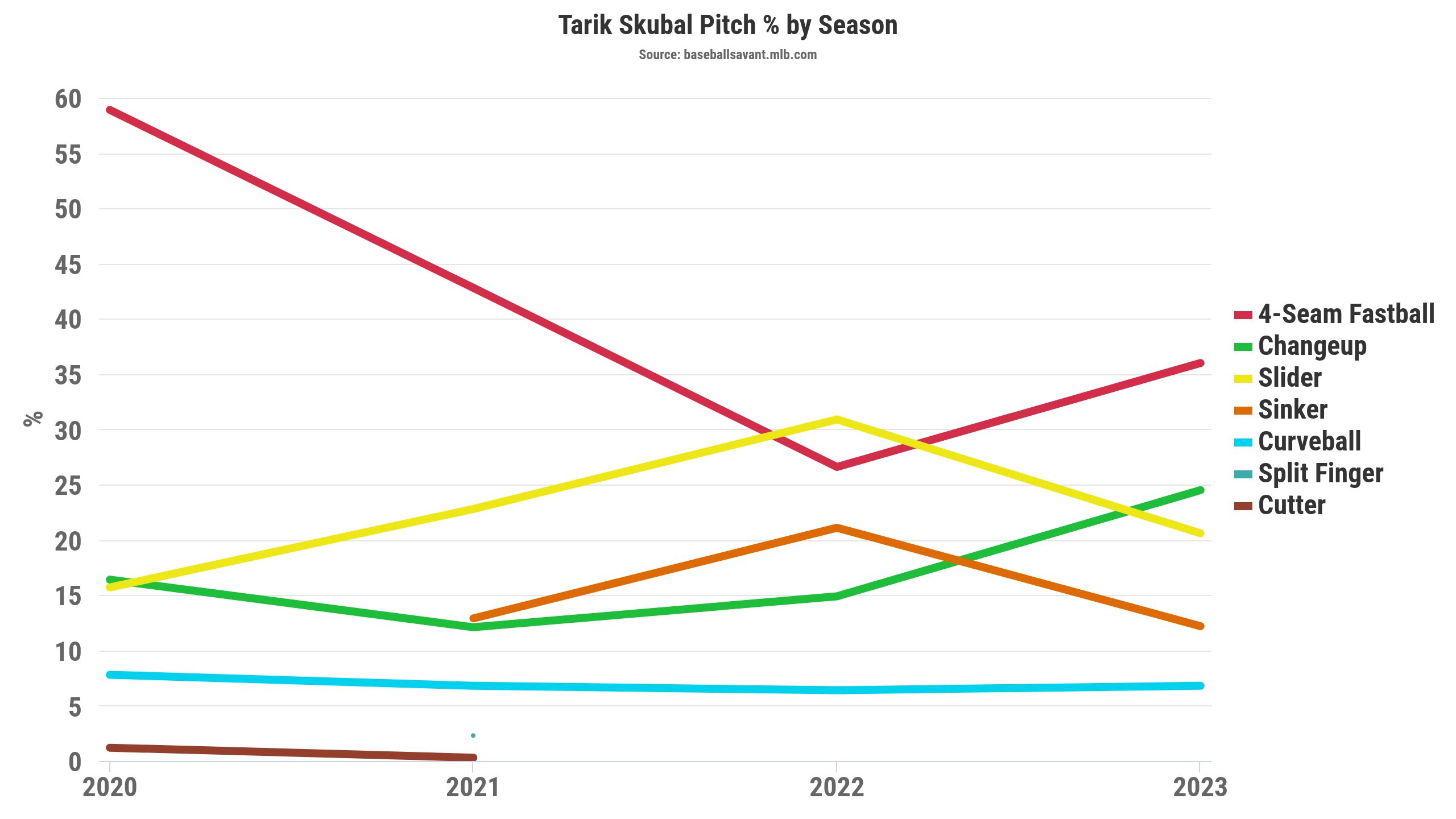 Image credit: Baseball Savant
Image credit: Baseball Savant
Skubal adjusted from a slider-fastball pitcher to a fastball-changeup guy. And among changeups thrown at least 250 times in 2023, Skubal’s had the third-highest whiff rate and second-lowest wOBA allowed (.181).
He’s also moderating his fastball usage while utilizing his sinker more as a front-door pitch to right-handed hitters.
Skubs using his sinker as a good front-door pitch to righties pic.twitter.com/d5MASVAik2
— Tanner McGrath (@tannerstruth) February 7, 2024
It’s an excellent mix for a southpaw, but the mechanical adjustments have made it deadly.
Regarding his slider, Skubal severely limited its use in 2023, mainly by keeping it away from right-handed hitters – instead opting for his fastball mix – and throwing it down and away to southpaws more.
Skubal keeping his slider low-and-away from lefties was pretty big last year pic.twitter.com/q3wdzYQleI
— Tanner McGrath (@tannerstruth) February 7, 2024
As he began dominating early counts with heat, Skubal was able to keep his slider low and out of the zone in pitcher’s counts. He posted a career-low zone rate, a career-high low-location rate, and a career-high two-strike-chase rate on the pitch in 2023.
Data via Pitcher List
Per Stavenhagen, Skubal focused on keeping consistent depth with his slider, making sure it didn’t morph into a “harder cutter-like pitch that got him in trouble a couple of times in the 2022 season.”
Either way, the Stuff+ on Skubal’s slider jumped to 114 in 2023 from 97 in 2022. Stuff+ grades it as his only above-average pitch, but the model isn’t excellent at analyzing changeup-heavy southpaws, so take that with a grain of salt.
More importantly, Skubal threw fastballs for strikes and kept his breaking balls out of the zone, ultimately increasing his chase rate and lowering his walk rate – Skubs posted a career-low walk rate (4.5%) and career-high chase rate (38.4%) in 2023.
I must emphasize one final point: Skubal is not a hard-throwing, hard-contact pitcher like Strider. Skubal induces a crazy amount of weak contact, specifically from the increased use of his changeup, which forces a near-60% ground-ball rate.
Skubal posted a career-high ground-ball rate (51.6%), a career-low home-runs-per-nine-innings rate (0.45), and a career-low hard-contact rate (27.2%) in 2023 – the latter mark ranked seventh among pitchers with at least 80 innings pitched. He kept his xBA below .200, his barrel rate below 5%, his average launch angle under 10 degrees, and his sweet-spot rate under 25%.
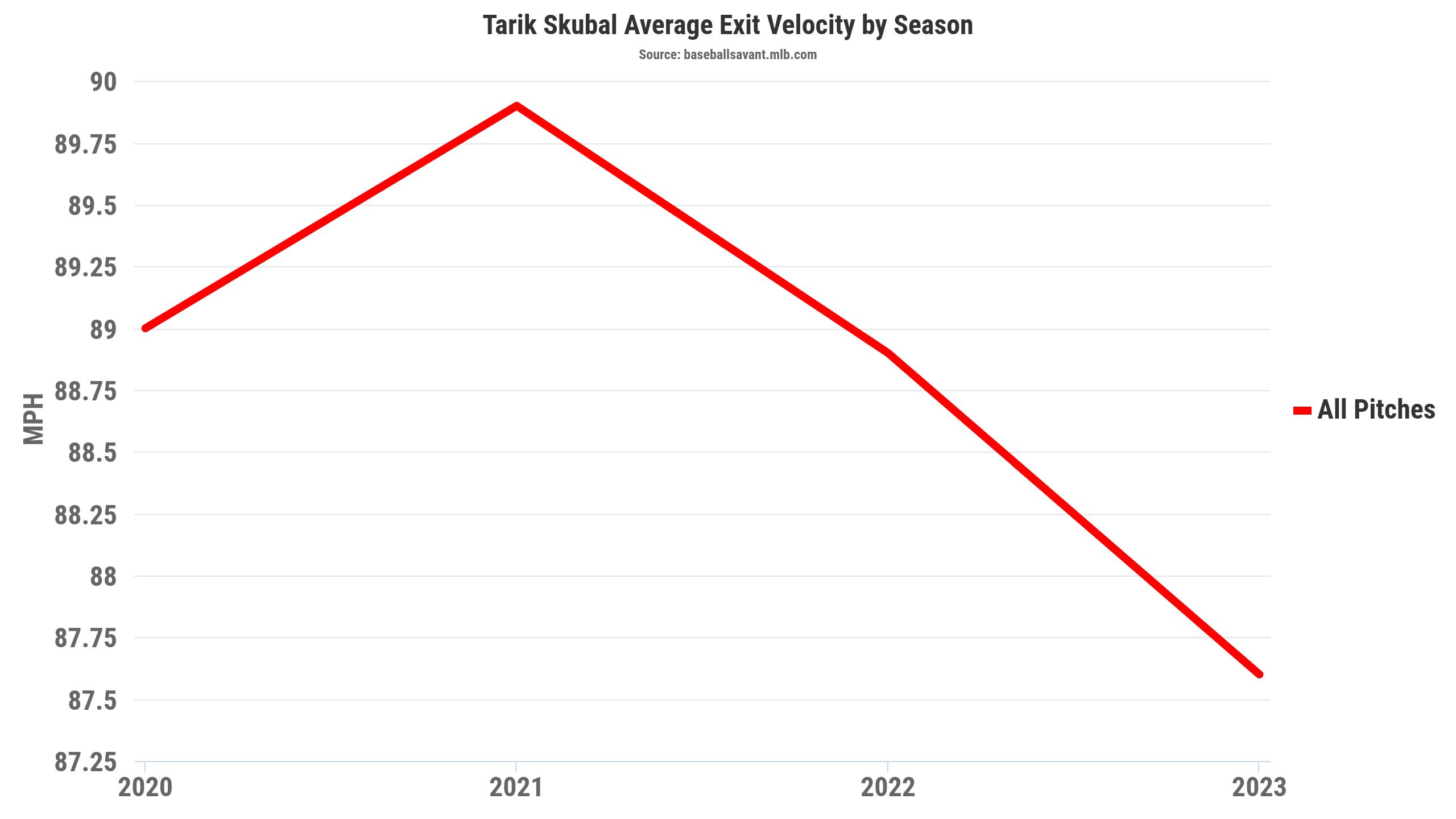
Image credit: Baseball Savant
Some of this is due to playing in Comerica, which has MLB’s lowest Statcast home run factor. Still, Skubal had a long-ball problem coming up to the majors, allowing a whopping 35 across 150 innings in 2021, including 13 in 91 Comerica innings (1.28 HR/9). Even if he falls somewhere in the middle of his early and more recent years, it’s clear Skubal’s improved mightily in homer avoidance.
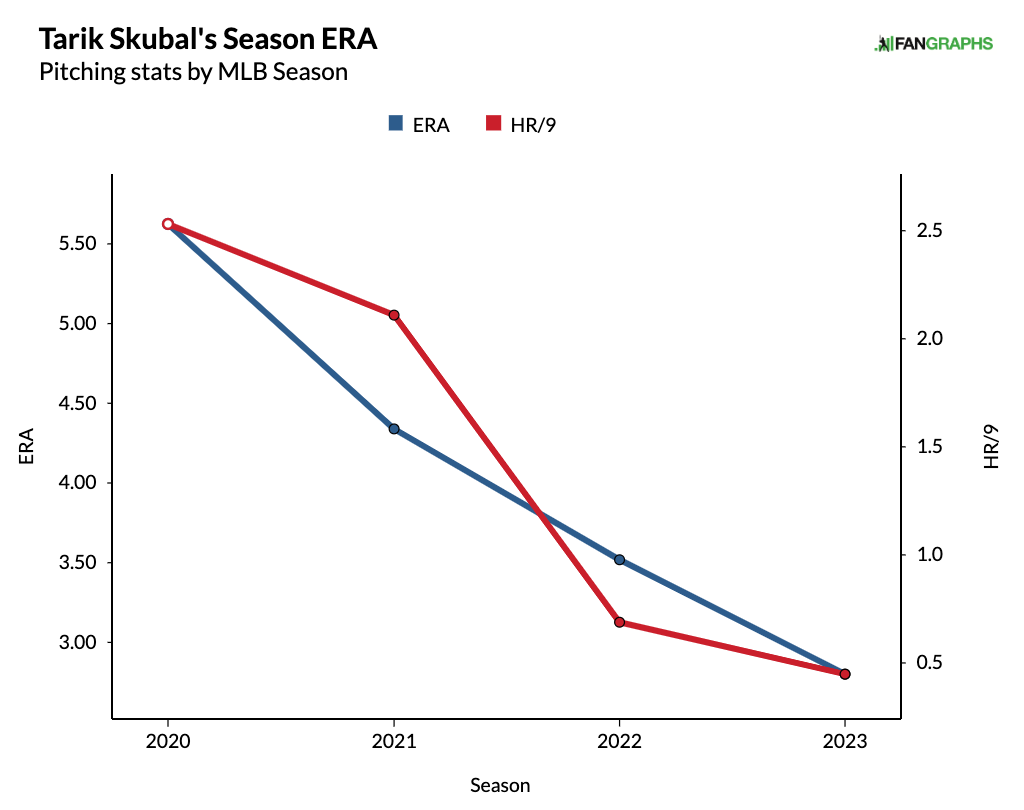
Image credit: FanGraphs
The only pitch that could be nit-picked from a batted-ball perspective is the slider, which allowed a .450 slugging and .320 wOBA. However, some of that was bad luck, given his xSLG (.321) and xwOBA (.278) allowed on the pitch were much lower.
And, as alluded to, some of that was poor decision-making. Skubal threw his slider 30% of the time against righties in 2022 – his most-used pitch against the side – but only 18% of the time in 2023. He avoided trouble by avoiding flat, hanging sliders breaking into the zone on right-handed hitters. In other words, he limited the use of his worst pitch.
Skubal re-worked almost everything during his nearly-year-long rehab process, and it’s coming together for the 27-year-old soon-to-be ace.
The Results
Let’s look at Skubal’s year-over-year improvements side-by-side.
Data via FanGraphs
Data via Pitcher List
The final data point, PLUS%, is defined as CSW plus foul balls plus balls-in-play outs, essentially measuring how often a pitch results in a positive event.
Skubal’s 2022 mark was the best in baseball. Nobody produced more good from their pitches than the Tigers lefty.
Projections and Outlook
I don’t think Skubal’s breakout is luck-based.
He isn’t running all that well. Skubal’s .288 BABIP over the past two seasons isn’t crazy low, especially considering his high ground-ball rate. And his 67.6% left-on-base rate is crazy low, the seventh-lowest mark among starting pitchers with at least 180 innings pitched during the two seasons.
His improvements are mechanically based, and there isn’t a big split between his actual and expected results.
Data via FanGraphs and Baseball Savant
Skubal could actually see positive LOB% regression in 2024. That’s a scary thought.
However, Skubal could see some negative regression in other areas. I doubt he replicates a sub-10% home-run-to-fly-ball rate over a hopefully lengthy season — which he’s done in the past two injury-shortened seasons — even when pitching in Detroit half the time. For what it’s worth, most projection systems tag him for around 1.00 home run per nine innings in 2024, which seems reasonable.
Let’s talk about those projections more.
Some are aggressive. Steamer projects Skubal with the eighth-most WAR among starting pitchers in 2024 (4.0), pegging him for a 3.44 ERA with a 28% strikeout rate. PECOTA projects him with the second-most WARP (2.4), even if it thinks his ERA will balloon to 3.68.
Some are more mild. ZiPS is a little low on Skubs, projecting him as MLB’s 17th-most valuable pitcher with 3.4 WAR and a 3.65 ERA. Of note, ZiPS is much lower than the market on his strikeout upside, projecting him with a surprisingly low 25.5% rate and 9.37 per-nine rate.
Our Pitcher List projections lean toward the latter, projecting Skubal as MLB’s 15th-most valuable pitcher with a 3.54 ERA and 26.3% strikeout rate.
Here’s how he pans out across every significant projection site.
Data via FanGraphs, Pitcher List and Baseball Prospectus
Here’s the thing: many of the predictive analytics are building in his rookie and sophomore years to project future performance, but those metrics came before he made his mechanical and pitch-mix adjustments.
I can’t make an argument for Skubal regression. His strikeout rate is high and based on rock-solid underlying pitch-specific metrics, specifically from high heat, efficient location, and intelligent usage of secondary pitches. His FIP metrics are stupidly low – per Brendan Tuma, the difference between Skubal’s 2023 league-leading 2.00 mark and second-place Sonny Gray’s 2.83 mark is the same as the difference between Gray and 26th-ranked Eduardo Rodriguez’s 3.66. And his batted-ball profile is excellent, built upon a high ground-ball rate and a low hard-contact rate, even if he’s benefitted some from a pitcher-friendly park.
Most trendy pitchers I analyze have distinct splits between actual and expected stats. Or their success is being buoyed by BABIP and LOB% luck. Or they’re getting lucky with sequencing, so their high strikeout rates don’t match their whiff upside. Or their batted-ball profile is a mess despite being successful in four true outcome scenarios.
Skubal doesn’t fall into any of those categories, and it’s all based upon clear-as-day changes to how Skubal approaches the art of pitching.
There’s only one problem with Skubal: injuries. Most projections have Skubal pitching around 150 innings this year, with Pitcher List projecting 15 quality starts in 155. Steamer is very aggressive, projecting him for 198 strikeouts in 171. How reasonable is 150 innings for Skubal? How reasonable is 170?
I’m unsure.
He’s never cracked 150 innings in a season, managing only 32 in the shortened 2020 season and 117 before the extensive injury in 2022. Per The Althetic’s Greg Scholz, the re-injury potential for flexor tendon ailments isn’t overly concerning. Outside of that, Skubal has a pretty clean injury sheet – in the majors. It’s worth mentioning he had Tommy John when playing college ball at Seattle. But today’s doctors are so good, and TJ is becoming routine.
We simply haven’t seen the youngster put together a super high-usage season. And that worries me a tad.
But if there were ever a time for a super high-usage, high-efficiency season from Skubal, 2024 is it. He’s coming off only 80 legitimately dominant and healthy MLB innings in 2023 and a lengthy offseason, so there’s minimal wear and tear to worry about. He seems healthy!
I think I’m all in on Skubal. I’m buying stock in him as a potential top-five major league ace with Cy Young upside. Given his new-look arsenal and shining underlying statistical profile, I don’t think the projections are bullish enough.
Tarik Skubal Photo by Frank Jansky/Icon Sportswire | Adapted by Aaron Asbury (@aarongifs on Instagram)

This is fantastic deep dive and really fun to learn all about Skubal…